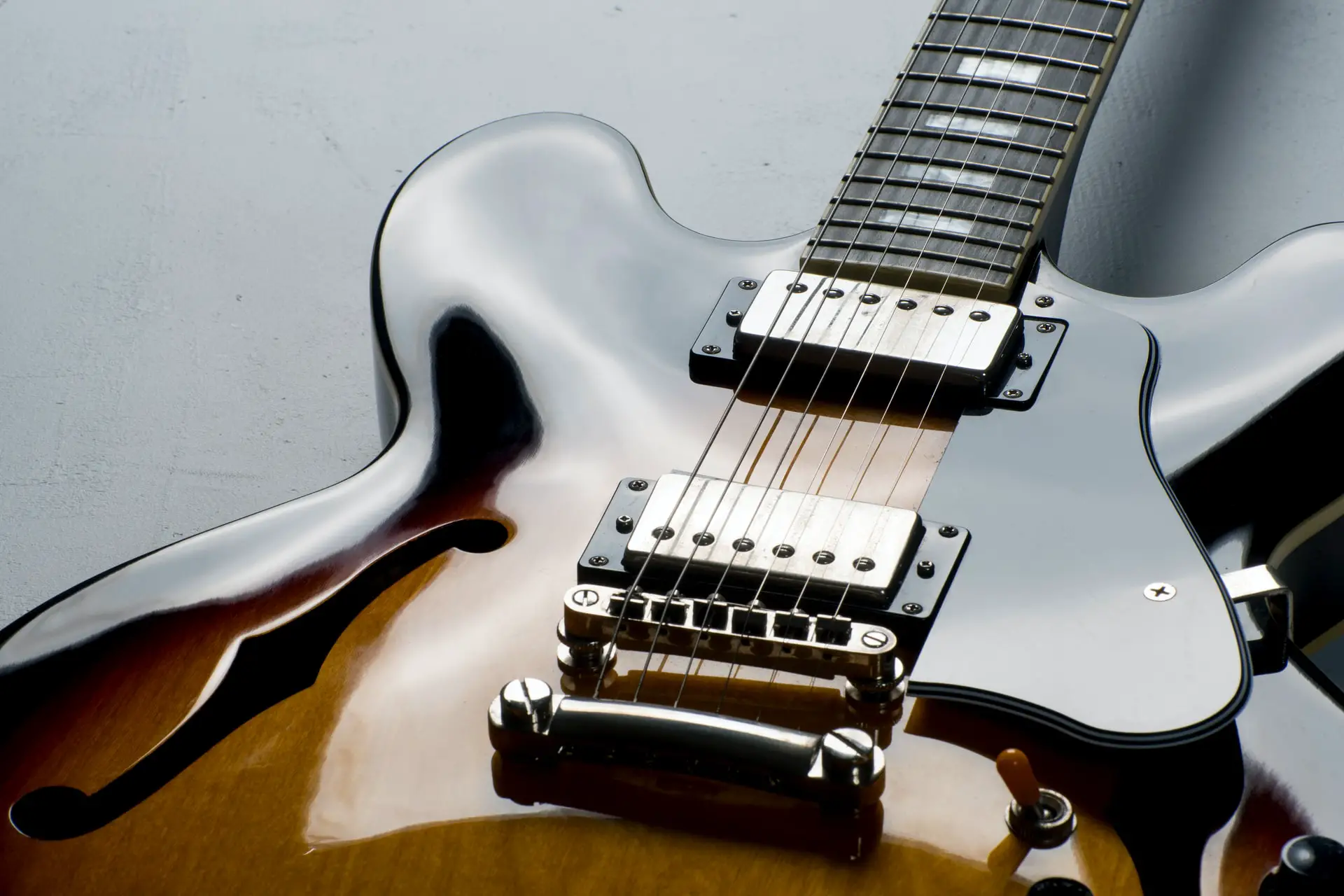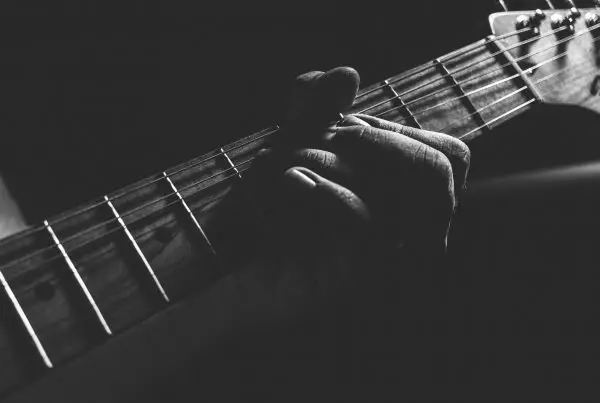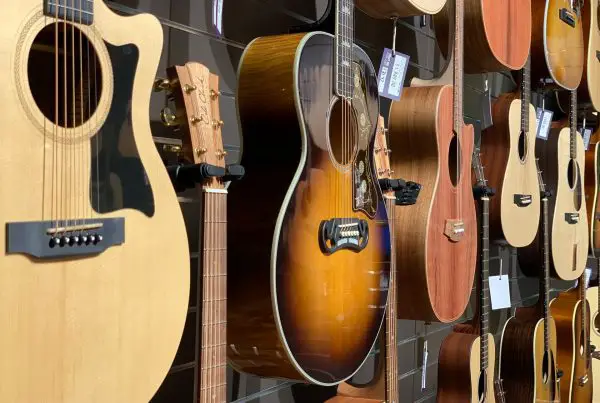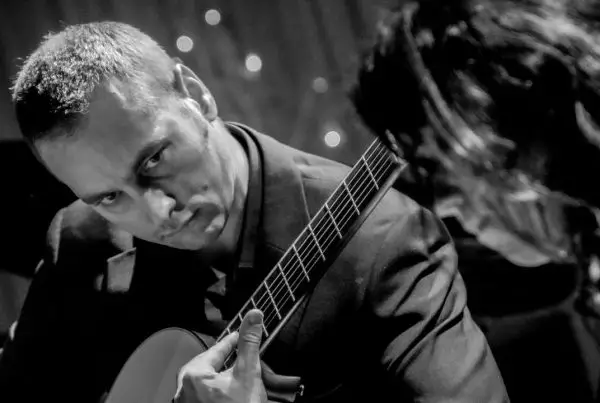Your guitar has a neck dive if the headstock dives towards the floor when you strap it around you – this happens because the weight between the guitar sections are divided unevenly.
To confirm for a neck dive, stand up in a playing position with the guitar strapped around you. Now simply let go of the guitar. If you notice your headstock “diving” towards the floor, this means that your guitar has neck dive.
I have seen neck dives famously exhibited in Gibson SG and Flying V guitars. Still, a lot of times, offset guitars will have the same issue, which comes from the body generally being offset, meaning the waist of the guitar isn’t straight up and down. The weight is divided unevenly, which can cause a little bit of neck dive.
In this article, I will discuss neck dive in guitars and its fixes in detail. Here’s the content we will cover:
- What is guitar neck dive?
- Does the weight of a guitar affect neck dive?
- Ways to fix guitar neck dive
- Frequently Asked Questions
What Is Guitar Neck Dive?
Neck dive occurs when the headstock of your guitar feels heavy compared to the rest of the body of the guitar, meaning that the fretting hand feels “heavier” than your strumming hand.
When not in a playing position, you will feel the headstock of your guitar “dive” towards the floor, where typically, your guitar’s body should be the heavier one.
It generally happens to the guitars that don’t have the front strap positioned around the 12th fret.
A lot of famous guitars suffer from this issue. Typical examples are the B.C. Rich Stealth and Mockingbird, the Gibson Explorer, SG, and the Flying V guitars.
Does the Weight of a Guitar Affect Neck Dive?
The weight of a guitar doesn’t affect neck diving. Actually, any type of guitar can suffer from a neck dive.
Neck dive isn’t really dependent on the weight of the guitar but more on the weight distribution in the body. If there is more weight towards the neck of the guitar, then the guitar may face from neck dive.
It also depends on how much more weight there is in the neck of the guitar. If the weight distribution ratio between the upper and the lower parts of the guitar’s body is similar, then the neck dive won’t be too much.
However, if the upper part of the body is much heavier, there is a chance that the neck of the guitar can hit the floor, causing severe damage to the guitar.
5 Ways to Fix Guitar Neck Dive
You shouldn’t worry too much if your guitar has neck dive, as most people tend to play around it. However, many guitarists find this very annoying and feel their hands tired after supporting the neck for long periods. If you’re looking to work around guitar neck dive, here are a few ways you can go about doing it.
1. Use a Grippy Strap
Getting a strap that grips your shoulder better is a great way to reduce neck dive and, in some cases, eliminate it. Make sure you get a wider strap, preferably with suede or cotton back, which will naturally grip onto your shirt a little better when you play.
Now, this doesn’t solve the underlying problem. It’s just a way to work around it. You will still feel a little weight in the palm of your hands while you play.
If your guitar has a massive neck dive, the grippy strap can make your shirt rise, which won’t look particularly pleasing to your audience.
However, if your guitar doesn’t have too much neck dive, this is an excellent option for you as a grippy strap can help keep it in place when you play.
2. Add Weights to the Strap
Reduce neck dive by attaching weights to the guitar’s strap – this adds more weight on the side of the guitar’s body and creates a more balanced weight. Preventing neck dive.
There are a number of ways you can do this. You can use fitness weights that can be wrapped around the guitar strap towards the guitar’s body. You can also buy inexpensive weights and put them in a pouch, and sew them to the strap of your guitar.
You can make use of belt weights (often used by divers), which have a slot where you can slide the strap in. However, in our case, they have a tendency to rub against the guitar and can damage the guitar’s finish.
3. Add Weights to Your Guitar
Stick adhesive weights in the cavity of your guitar to prevent neck dive – It’s a great option because most of these also come with an insulating coating, so there is no risk of your electrical components being shorted out.
Some people like to even use fishing weights on their guitars to prevent neck dive, and it can be a good choice if you’re on a budget, but be very careful as this can have an effect on the guitar’s electronics.
4. Reduce Weight at the Guitar’s Headstock
Switch to lighter tuners. More specifically, try to avoid locking tuners because they add more weight to the guitar’s headstock.
Oftentimes, guitarists like to utilize locking tuners as they have better tuning stability and allow faster string changes, but they tend to be heavier than their non-locking counterparts. You may notice that you have more guitar neck dive when you start using these heavier tuners.
Tuners likely aren’t why your guitar has neck dive, but they can contribute to the additional neck weight.
I recommend switching them out to something lighter. You can easily find lightweight tuners specially made for reducing weight of the guitar’s headstock.
The main goal is to reduce the weight in the headstock and increase it in the body, so I recommend using this tip and adding weights to the strap or the body of the guitar.
5. Relocate the Strap Buttons
Relocating the neck strap button to a more ergonomic location is the best way to solve most neck dive problems without removing or adding weight to your guitar.
This tip is a tad drastic, but here you get a more permanent solution to guitar neck dive. As I explained before, the positioning of the strap buttons is what causes neck dive.
This does involve drilling a hole into the guitar, so proceed with caution. Before you start drilling holes into your guitar, make sure to experiment with different locations for your straps. You can use this using strong adhesive tape.
Once you’re sure to find the best place for your strap button, you can proceed to drill.
Make sure to drill a smaller hole than the screw so the screw can be tightly fitted and ensure that the screw isn’t too long to stick out of the other side of the body.
Conclusion
Some guitar models tend to have more neck dive than others. This doesn’t mean that there’s a problem with your specific guitar. You can use the fixes I mentioned above to fix or lessen neck dive significantly.
I hope this article helped you understand what neck diving is and how to get around it if you have this problem with your guitar.
Frequently Asked Questions
Does Les Pauls have neck dive?
Les Pauls have the tendency to neck dive because they don’t have a top horn on the body.
Les Pauls can be very uncomfortable to play. However, This can be fixed using a long bolt-on strap bolt, but this isn’t the ideal solution as the underlying problem exists in the design of the body.
How do you deal with an SG neck dive?
A simple way to solve neck dive in an SG guitar is to drill and screw in the strap button on the neck of the guitar. Use a strap lock so the straps can stay in place, and they also help provide extra height to the straps.
Do Gibson Explorers have neck dive?
Gibson Explorers do suffer from neck dive because they have an offset body – meaning they don’t have an extended top horn on their body. So I recommend using adhesive weights in the control cavity of the guitar to help with the neck dive.
Can I fix neck dive permanently?
You can fix neck dive permanently, but it requires a significant amount of effort. For guitars that don’t have an extended top horn, Irecommend screwing on a custom horn to put the strap on the guitar.
This will help with the weight distribution of the guitar permanently. If done correctly, you can totally eliminate neck dive on your guitar.
Why does my fretting hand get tired when playing?
If your fretting hand gets tired, then there is a chance that your guitar is neck-heavy. You may not notice the neck dive, but that doesn’t mean there isn’t any.
If your fretting hand gets tired after playing for a while, try adding weight to your straps, and you should feel the extra weight gone from your hands.





